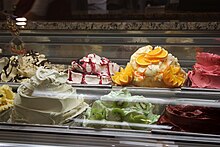Gelate
Gelatiere (Mz. Gelatieri ), also Gelataio , is the Italian and often used in other countries name for an old craft in gastronomy . Gelatieri deal with the artisanal production of ice cream and its distribution in ice cream parlors , ice cream parlors or ice cream parlors and in outpatient sales . Ice cream parlors are traditionally run as a family business and are mostly owned by a number of Italian families who originally come from the Dolomites , both in Italy and abroad .
In the German-speaking world, the profession is also known as an ice cream maker , while the outpatient ice cream seller is known colloquially as an ice cream man . In Germany , from 2008 to 2014, there was a two-year vocational training course to become an ice cream maker and from 2014 to 2019 a three-year training course to become an ice cream specialist .
Jobs for gelato and ice cream manufacturers etc. can also be found in the ice cream industry.
Gelatieri Valley
Around two thirds of the 4,000 ice cream parlor owners in Germany come from the “ Val di Zoldo ” and the neighboring “ Val di Cadore ” in the Dolomites , both of which are known as the “Valley of the Gelatieri”. Since the end of the 19th century, farmers from the then poor Belluno emigrated to northern Europe in order to open ice cream parlors there, as they could no longer live from the sale of their agricultural products and the business of the traditional wood and nail production had collapsed. According to tradition, they should have learned their skills from a Sicilian. Ice from the glaciers was used to cool the ice cream .
Spread in Europe
In 1865 the first gelato from Zoppè di Cadore emigrated to Vienna and received permission to set up an ice cream van in Vienna's Prater . In order to protect the local traders, the Viennese authorities later refused the Italians the trade license for the outpatient trade. The Gelatieri were forced to rent business premises, which they furnished with benches and kerosene lamps: the ice cream parlor (Italian: gelateria) was born. From Vienna as the starting point, the ice cream makers swarmed over Central Europe after 1880.
The Gelatieri in Germany
The two world wars meant setbacks for their business after the Gelatieri had settled between the wars in Germany, especially on the Rhine and Ruhr, although the German-Italian alliance favored this from the 1930s. After the axis broke in 1943, almost all gelatieri left Germany, but many came back during the economic boom in the 1950s. Even today there are many Italian "ice cream parlors" in the Ruhr area ; The name came about because the gelatieri initially sold their ice cream from their own apartments on the ground floor. So that customers could reach the opening, they attached wooden boards - floorboards - under the windows.
The gelatieri today
The Gelatieri families used to spend the summer season in Germany, but the winter in their homeland, and the ice cream parlors were closed around mid-October. This tradition has partially changed with the third and younger generations: The younger family members no longer feel so strongly attached to their homeland. In addition, many Italians no longer want to take over the family's ice cream parlor; these are increasingly run by Germans or members of other nationalities. Unlike in the past, ice cream is eaten in winter too, so it's worth keeping the ice cream parlors open. On the other hand, the cost pressure has increased so that many ice cream parlors remain open all year round and also have to offer small dishes in order to remain profitable.
The Gelatieri joined the “Union of Italian Ice Cream Manufacturers in Germany” in 1969. V. “(Uniteis). In 2009 the association had around 1,500 members with 2,200 ice cream parlors. Every year in November since 1959, the large ice cream trade fair "Mostra Internazionale del Gelato Artigianale" takes place in Longarone at the foot of the Zoldo Valley.
"Ice cream maker" has been a recognized training occupation in Germany since 2008.
Well-known gelatieri
A prominent “gelatiere” is Nevio De Zordo from Cologne , who won a silver medal as a bobsledder in Sapporo at the Winter Olympics in 1972 and was twice world champion.
Individual evidence
- ↑ Uniteis.com: "Ice Pioneers - The Italian Gelatieri" ( Memento from September 14, 2012 in the web archive archive.today )
- ↑ dieruhr.de: "How the ice came to the Ruhr area"
- ↑ Uniteis.com ( Memento of the original of July 24, 2008 in the Internet Archive ) Info: The archive link was automatically inserted and not yet checked. Please check the original and archive link according to the instructions and then remove this notice.
- ↑ Mostra del Gelato
- ↑ Zeit.de of October 11, 2007: "Sporty Gastronom" ( page no longer available , search in web archives ) Info: The link was automatically marked as defective. Please check the link according to the instructions and then remove this notice.
literature
- Donata Panciera, Paolo Lazzarin, Tarcisio Caltran (1999): La storia del gelato. Dall'epopea dei gelatieri alla Mostra Internazionale del Gelato / How the ice cream was made. From the age of ice cream manufacturers to the international ice cream fair. (Italian / German). Cierre Edizioni. Caselle di Sommacampagna (VR), Italy. ISBN 978-8-8831-4046-4 .
Other sources
- Zeit.de of April 1, 2004: "The Valley of the Gelatieri"
- LWL-Industriemuseum.org ( Memento from June 23, 2009 in the Internet Archive )
- Museo Etnografico Zoppè di Cadore: "Storia dell 'emigrazione di Zoppè" (Italian)

